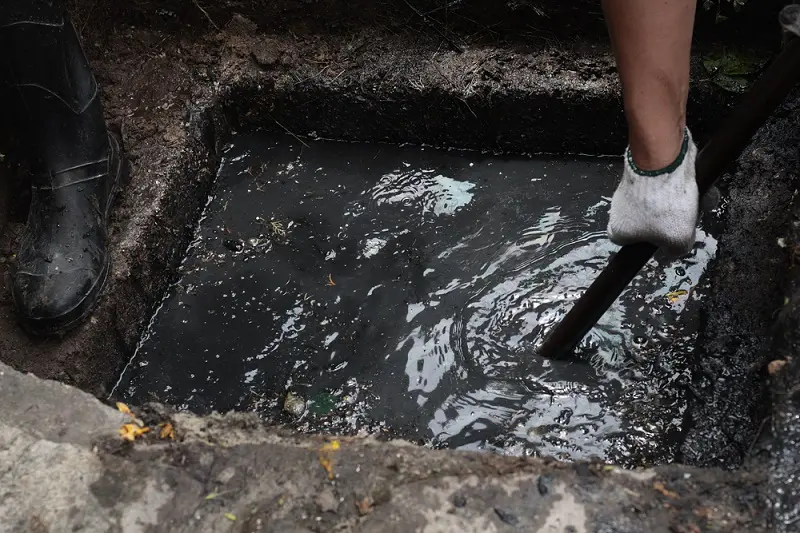Like most homeowners, you probably don’t think about your septic tank until there’s a problem. And when that happens, it’s usually a big one! If your septic tank is backed up, it’s important to take action immediately to avoid further damage.
How Do You Unclog A Septic Tank Yourself?
The best way to unclog a septic system is to determine what is blocking it. Some clogged pipes are caused by a buildup of scum and debris around the pipe. These can clog the tank and prevent it from filling.
Often, the problem is a clog in a branch drainage pipe between the house and the septic tank. This can be caused by tampons, wet wipes, condoms, and paper towels. Alternatively, a clog may be inside the effluent filter or outlet baffle. If you can access these system parts, you can unclog it yourself by pushing a pole through the access port and removing the clog.
If baking soda does not work, you can try using a solution of white vinegar. This solution is non-toxic and won’t damage your septic tank’s ecosystem. If the septic tank is backed up, you may need a professional.
When cleaning the pipes, don’t use strong chemical cleaners. These can kill beneficial bacteria and disrupt the bacterial balance in your system. Alternatively, you may consider using a five-to-one solution of water and bleach. Let the tools soak in the solution for about five minutes before draining them back into the septic tank. Remember to use bleach or laundry sanitizer on your clothes after using the solution.
Is Baking Soda And Vinegar Good For Septic Systems?
There are a few things that you should know before using baking soda and vinegar on your septic system. First, you should know that they will damage your septic system. The process of cleaning your septic system will require the use of enzymes and beneficial bacteria. The best source of these enzymes and bacteria is rotten tomatoes. These natural products contain Pectinase and Pectinolytic enzymes that will break down waste in your septic tank. In addition, you should never put grease down the sink or garbage disposal because it is not biodegradable and will clog the main line.
While vinegar and baking soda do not kill the harmful bacteria in your septic system, they help it function properly. They can help break down waste and prevent the unpleasant smells that come with them. They are much better alternatives to bleach, which can kill the beneficial bacteria in your septic tank. Baking soda is also safer than vinegar, which can harm the environment.
In addition to cleaning, these substances are also effective in disinfecting tools. For example, you can disinfect instruments by mixing one part chlorine bleach and five parts water. You should soak these tools in the solution for at least 5 minutes. Once they are dry, you can drain the solution into your septic tank. The solution can also be used to wash clothes.
What Can I Use To Unclog A Toilet With A Septic Tank?
There are several methods you can use to unclog a septic tank toilet, including the use of vinegar or boiling water. While neither of these methods guarantees a clear drain, they may clear a small clog.
Depending on the type of clog, boiling water isn’t the best choice. Boiling water can crack porcelain, and it’s unlikely to clear a clog caused by a hard object. Another option is to pour hot water from the waist level, which can help clear the clog by forcing water into the bowl.
Toilets that don’t drain can be extremely frustrating to deal with. Not only is it unsanitary to have the water running nonstop, but it’s also messy work. Toilet clogs may be caused by something trapped in the pipe, or it may indicate a larger septic tank problem.
Chemical drain cleaners may be an option for cleaning a septic tank, but they could upset the balance of bacteria inside the tank. A healthy balance of bacteria inside the tank will help break down solid waste.
Is It OK To Put Vinegar In A Septic System?
If you want to clean your drains, you can use vinegar as a natural cleaning agent. Vinegar is an inexpensive and natural product that is very powerful for cleaning. It helps break down dirt and soap scum. It also controls mold and mildew growth. Moreover, it is safe for septic systems because of its all-natural composition. You can even pour it into your garbage disposal to help it get rid of stuck-up sludge and other particles.
However, you must ensure that you don’t add too much vinegar to your septic tank. It may lower the pH of your septic tank, increasing its acidity. However, the sewage in your septic tank dilutes and buffers the vinegar.
You can use a solution of baking soda and vinegar to clean the interior of your septic system. Mix the two ingredients and let them sit for about 15 to 20 minutes. Then, flush the system with hot water. It’s safe to use vinegar in your septic system, but make sure you don’t use it in your garbage disposal because it can harm the system and cause clogs and backups.
How Can You Tell If Your Septic Tank Is Clogged?
The first sign of a clogged septic tank is a slow drain. Various causes, including tree roots, can cause slow drainage. The roots will clog the sewer line and must be cut off to prevent damage to the tank. Once they are cut off, call a plumber who will measure the sludge level and recommend an effective solution.
Another sign that the tank is not functioning properly is when you notice a sewer backup in your basement or toilet. These backups generally occur in the lowest drains first. Therefore, it is important to call a plumber right away to have the problem addressed.
If a clog is local, you can use baking soda and vinegar to unclog it. Place the mixture into the pipe and let it sit for one to two hours. Then, flush it with hot water. This should clear the clog.
Another warning sign of a clogged septic tank is gurgling. This occurs when something traps air inside the drain line. If you notice gurgling, chances are that your septic tank is full of sludge. A gurgling noise can also be an indicator of a clogged drain pipe.
Is Hydrogen Peroxide Safe For Septic Tanks?
Hydrogen peroxide is a common chemical that is used to treat septic tanks. It can be a very effective septic tank cleaning solution because it is inexpensive and safe. It is also effective for cleaning windows, humidifiers, and walls.
Hydrogen peroxide can effectively eliminate foul odors as it kills pathogenic bacteria. It can even help with reducing the smell of effluent. Because it is a powerful disinfectant, it can help reduce the risk of waterborne illness. However, hydrogen peroxide should be used in the proper dilution.
Adding a layer of good bacteria to the septic tank is also important. Brewer’s dry yeast is a great way to add good bacteria and help break down waste. In addition, hydrogen peroxide can help with toilet cleaning. To clean your toilet, pour some hydrogen peroxide once a week. Hydrogen peroxide is safe for septic tanks and won’t damage your water systems.
Hydrogen peroxide is safe to use in septic tanks at concentrations of between 25% and 65%. However, high concentrations pose substantial health and safety risks. Consequently, the right concentration for your septic tank will depend on the size and type of your system.
Should I Add Anything To My Septic Tank?
If you are wondering whether you should add anything to your septic tank, the answer is no. The bacteria in your system will continue to feed off the waste in your system. However, adding additives may be necessary if your system is already overloaded or you’re regularly flushing things down the drain.
The problem with chemical additives is that they harm your septic tank and pollute the environment. Biological additives, however, are completely safe for your septic system and will improve its efficiency. However, not all additives are created equal. Bio-Sol additives, for example, are made from Bacillus bacteria.
If you are using a home treatment, try to avoid adding feminine hygiene products, kitty litter, cigarette butts, and paper towels. These can all clog your tank. It would be best to consider how much water you use in your home. To help your septic tank, try combining laundry loads and running the dishwasher only when it is full. You should also remember to put your feminine hygiene products and baby diapers in the trash can. These products can interfere with your septic tank’s bacterial composition and saturate the drain field.
Chemical additives can be harmful to your septic system as they kill beneficial bacteria. In addition, they can corrode pipes and the tank itself. You should also avoid using enzyme additives in your septic tank. These additives can make solids float into the drain field, causing clogs.
Conclusion
A septic tank clog should not be fixed by someone with minimal training or who lacks tools. Call a septic tank pumping company to fix the problem if you believe your septic tank is clogged. If you open the lids to your septic tank and see water coming into the riser, like in the picture to the right, you have an issue with your septic system, and should have your septic tank pumped.



